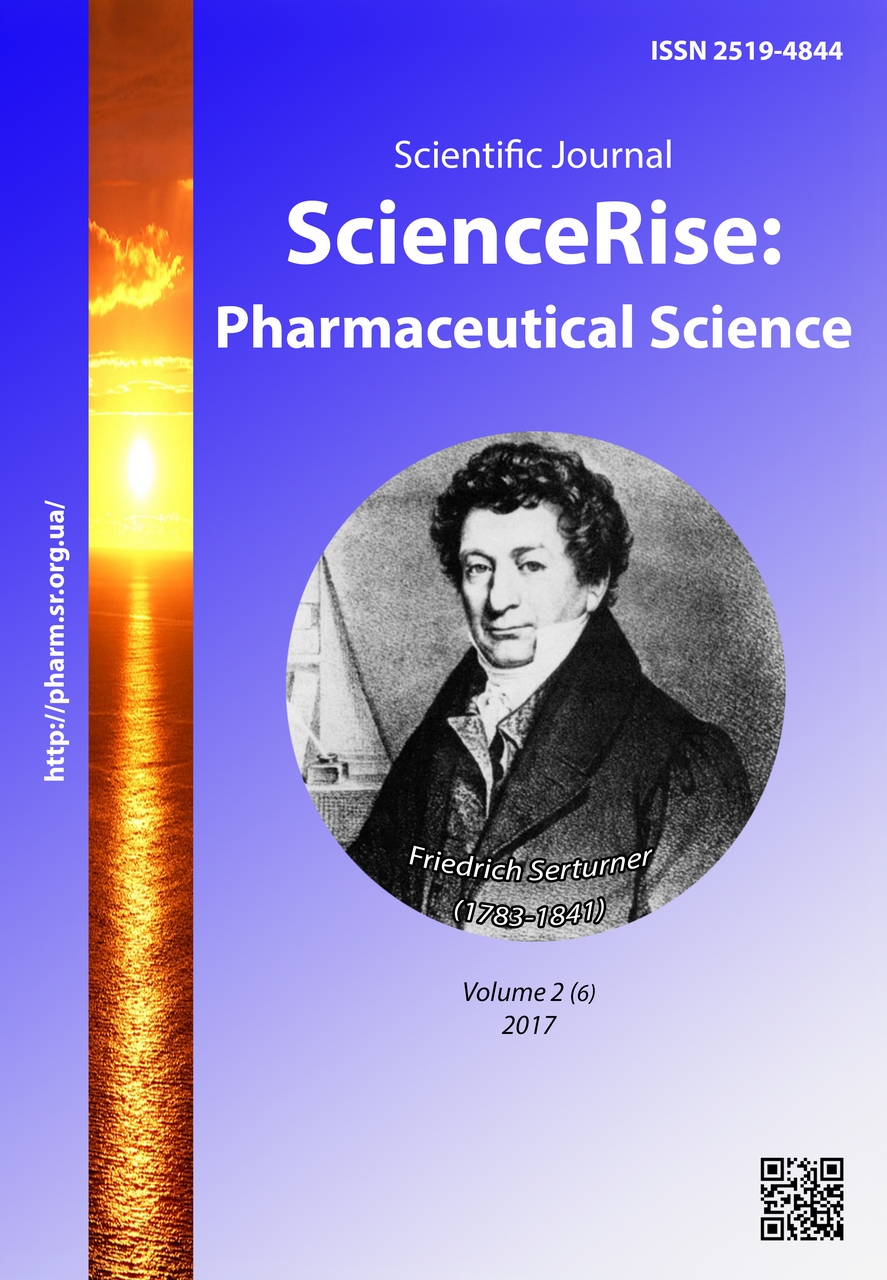The analysis of succinate dehydrogenase and lactate dehydrogenase activity in acute and chronic hypoxia on the background of 2-benzamide-2-(2-oxoindolin-3-ylidene) acetic acid derivative administration
DOI:
https://doi.org/10.15587/2519-4852.2017.98164Keywords:
antihypoxants, succinate dehydrogenase, lactate dehydrogenase, hypoxia, 2-benzamide-2-(2-oxoindolin-3-ylidene) acetic acid derivatives, MexidolAbstract
Aim. To study the influence of 2-benzamide-2-(2-oxoindolin-3-ylidene) acetic acid derivative ZNM on succinate dehydrogenase and lactate dehydrogenase activity biochemical markers of energy metabolism and hypoxia in the rats’ brain under acute hypobaric hypoxia (AHH) and normobaric hypercapnic hypoxia (NHH), as well as chronic hypobaric hypoxia (CHH).
Materials and methods. 80 white nonlinear mature male rats 180-200 g in weight were used for research. AHH was modeled using flowing altitude chamber by stimulation the effect of12000 m altitude “ascending” in rats. The rats were kept at the "high-altitude plateau" till the moment of the second agonal inspiration, then the “descent” to the previous zero height was performed.
NHH was reproduced by placing the rats into a sealed chamber, 1000 ml capacity, and then duration of stay of the rats in a closed chamber from the moment of container closing till the second agonal inspiration was estimated.
CHH was modeled in the flowing altitude chamber by stimulation the effect of4000 maltitude above sea “ascending” in rats. The animals were kept at this “height” during 2 hours every day within 4 weeks; hypoxia sessions were carried out before midday.
The studied substances were administered intraperitoneally 35 minutes before hypoxia modeling. The studied substance ZNM was administered in the dose of 15 mg/kg as water suspension, stabilized with Polysorbate 80. The reference drug Mexidol was administered in the dose of 100 mg/kg. The intact animals took an equivalent amount of water for injection with Polysorbate 80. The group of animals with stimulated CHH was treated by the remedies after 14th day of hypoxia modeling.
Results. The activity of succinate dehydrogenase after ZNM administration, depending on the hypoxia type, significantly increased in the AHH group in 2.6 times, and in the NHH group – in 1.6 times comparing to the model pathology group. After Mexidol administration, the activity markers raised in the AHH group in 2.9 times, NHH – 1.7 times, CHH – in 1.3 times.
At the same time, the activity of lactate dehydrogenase after ZNM and Mexidol administration decreased in the AHH group in 1.5 times, NHH – in 1.3 times (in 1.5 times after Mexidol administration). Under CHH conditions, the activity of lactate dehydrogenase after Mexidol administration stayed unchanged, and after ZNM administration it slightly but statistically significantly decreased by 7.5% compared to the model pathology indexes.
Conclusion. ZNM substance and the reference drug Mexidol normalize activity of succinate dehydrogenase and lactate dehydrogenase, which indicates the improvement of energy metabolism of cells in acute and chronic hypoxia
References
- Usenko, L. V., Tsariov, O. V. (2016). Modern Opportunities of Energy Protection in Critical States. Emergency medicine, 4 (75), 72–78. doi: 10.22141/2224-0586.4.75.2016.75820
- Novykov, V. E., Levchenkova, O. S. (2013). Novye napravlenyya poyska lekarstvennykh sredstv s antyhypoksycheskoy aktyvnostʹyu y mysheny dlya ykh deystvyya. Eksperymentalʹnaya y klynycheskaya farmakolohyya, 76 (5), 37–47.
- Levchenkova, O. S., Novykov, V. E., Pozhylova, E. V. (2012). Farmakodynamyka y klynycheskoe prymenenye antyhypoksantov. Obzory po klynycheskoy farmakolohyy y lekarstvennoy terapyy, 10 (3), 3–12.
- Rukan, T. A., Maksymovych, N. E., Zymatkyn, S. M. (2013). Aktyvnostʹ nekotorykh fermentov v neyronakh frontalʹnoy kory holovnoho moz·ha krys v rannyy postyshemycheskyy peryod. Vestnyk VNMU, 12 (2), 50–54.
- Tsubanova, N. A., Shtryhol, S. Yu., Horbach, T. V. (2012). Vplyv spirotsyklichnoho pokhidnoho oksindolu na pokaznyky tserebralʹnoho enerhetychnoho obminu v umovakh hipoksychnoyi ta nehipoksychnoyi patolohiyi. Klinichna farmatsiya, 16 (4), 51–54.
- Kolisnyk, S. V., Kononenko, N. P., Haman, D. V., Kotenko, O. M. (2011). Zv'yazok "struktura-antyhipoksychna aktyvnistʹ" u ryadu pokhidnykh 2-benzamido-2-(2-oksoindoliniliden-3)-otstovoyi kysloty. Visnyk farmatsiyi, 4, 64–66.
- Zamorskii, I. I., Bukataru, Yu. S., Lenga, E. L., Kolisnyk, S. V., Altukhov, О. О. (2016). Screening of derivatives of 2-(benzoyilamino)(1-r-2-oxoindolin-3-ylidene)acetic acid under the conditions of acute hypobaric hypoxia. News of pharmacy, 1, 67–70.
- Vazhnycha, O. M. (2001). Antystresorna aktyvnistʹ meksydolu i rolʹ strukturnykh komponentiv preparatu v yiyi realizatsiyi. Klinichna farmatsiya, 5 (2), 60–63.
- Poshuk i eksperementalʹne vyvchennya potentsiynykh protyhipoksychnykh zasobiv (2002). Kyiv: Ministerstvo okhorony zdorovʺya. Derzhavnyy farmakolohichnyy tsentr, 27.
- Pasevych, S. P., Zamorsʹkyy, I. I. (2014). Antyoksydantnyy potentsial pokhidnykh 3-oksypirydynu za umov khronichnoyi hipoksychnoyi hipoksiyi. Ukrayinsʹkyy biofarmatsevtychnyy zhurnal, 5, 9–12.
- Kamyshnykov, V. S. (2009). Spravochnyk po klynyko-byokhymycheskym yssledovanyyam y laboratornoy dyahnostyke. Moscow: MEDpress-ynform, 896.
Downloads
Published
How to Cite
Issue
Section
License
Copyright (c) 2017 Іgor Zamorskii, Yuliana Bukataru, Svitlana Melnychuk

This work is licensed under a Creative Commons Attribution 4.0 International License.
Our journal abides by the Creative Commons CC BY copyright rights and permissions for open access journals.








